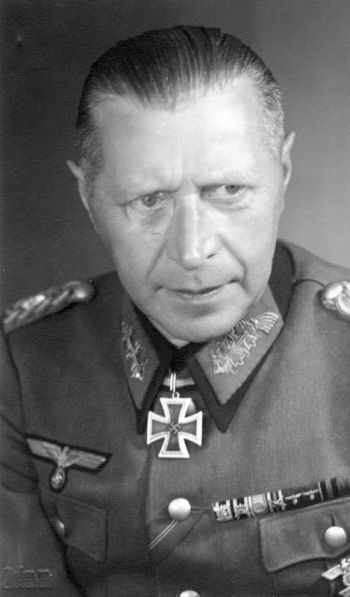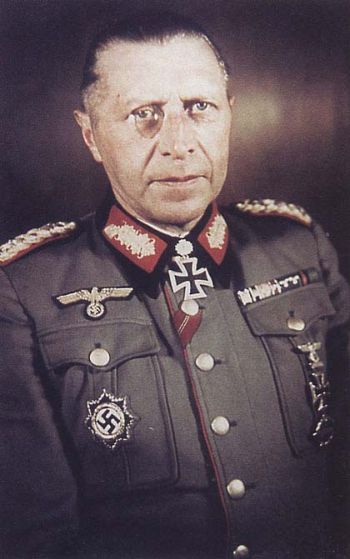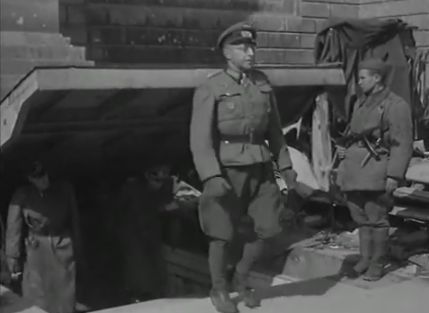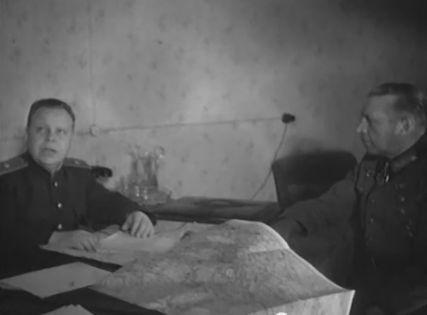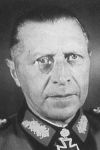Introduction
'On April 30, 1945, the Führer has committed suicide, letting down all those who had sworn the oath of loyalty to him. Obeying the order of the Führer, you German soldiers were keen to continue the battle for Berlin although your ammunition was running out and the general situation made further resistance futile. I hereby order the immediate cessation of all hostilities. Every hour you continue fighting will prolong the enormous suffering of the citizens of Berlin and of our injured. In agreement with the supreme command of the Soviet forces, I call upon you to suspend the fighting immediately.
Weidling, former commander of the defense of Berlin.'
The above capitulation order was read on radio on May 2, 1945, by the commander of the LVI Panzerkorps and Kampfcommandant of Berlin, Helmuth Weidling, marking the end of the hopeless struggle in Berlin. It is also characteristic for Weidling himself as he only became known to the general public by the movie ‘Der Untergang’ (the downfall) and in particular by his role in the battle for Berlin. Yet, he had a whole life behind him with an impressive military career.
Definitielijst
- capitulation
- Agreement between fighting parties concerning the surrender of a country or an army.
- Führer
- German word for leader. During his reign of power Adolf Hitler was Führer of Nazi Germany.
- resistance
- Resistance against the enemy. Often also with armed resources.
Life and military career
Helmuth Otto Ludwig Weidling was born November 2, 1891 in Halberstadt in the present federal state of Sachsen-Anhalt. Relatively little is known about his youth and childhood. In 1911 however, young Weidling entered the military world as Fahnenjunker (cadet) and a year later, he was promoted to Leutnant (lieutenant) in the Luftschiff-Battalion, making aerial observations from Zeppelins. Prior to and during World War One he was an artillery observer and later on he commanded a battery. After Germany’s defeat in 1918, he was drafted into the new Reichswehr where he would hold various functions. June 1, 1922 saw him promoted to Hauptmann (captain) of the 4. Artillerie-Regiment. The next 10 years, Weidling remained loyal to his rank until he was promoted to Major on June 10, 1932, while having served on the Stab des Infanterieführers (staff of the infantrycommander) of 1. Division since 1931. Three years later, on September 1, 1935, he was promoted to Oberstleutnant in the Wehrmacht, the new German army which was being fully developed in the mean time thanks to the Nazis.
Weidling was to carve out a very successful career for himself in the Wehrmacht. March 1, 1938, saw him promoted to Oberstleutnant. A few months later, he was put in command of Artillerie-Regiment 56 and as such he took part in the conquest of Poland in September and October 1939, triggering the outbreak of World War Two. Subsequently he was made commander of Artillerie-Regiment 56. On April 10. 1940, he was appointed artillerycommander in XXXX Panzerkorps, taking part in the conquest of France in May and June 1940. From June 1941 onwards he and his Panzerkorps took part in Operation Barbarossa, the campaign against the Soviet Union. A few months later, on New Year’s Day 1942 he was made commander of the 86. Infanterie-Division, an element of Heeresgruppe Mitte (army group center) and so he remained active on the Eastern front. Hardly a month passed before his new promotion on February 1, 1942 came along, this time to Generalmajor.
Weidling remained with the 86. Infanterie-Division until October 1943 as its commander and his unit took part in the fierce battles in the Ukraine and in others as well. Meanwhile. he was promoted to Generalleutnant on January 1, 1943. In this rank, Weidling was awarded the Ritterkreuz (Knight’s Cross on January 1, 1943 for meritorious service during the winter battle at Rzhev towards the end of 1943, one of the many prolonged and bloody battles on the Eastern front. On October 20, 1943, as the tides of war were already turning against Germany, he left the 86. Infanterie-Division to become commandeer of the XXXXI Panzerkorps. This Korps, part of Heeresgruppe Mitte, was also called Gruppe Harpe, after its previous commander, Joseph Harpe.
In 1944, Weidling rose further in the Wehrmacht hierarchy when he was appointed General der Artillerie on January 1. On February 22, 1944 he was also awarded the Eichenlaub zum Ritterkreuz (Oakleaves to the Knight’s Cross) for his leadership during the fierce battles between Pripyat and the river Berezina in Byelorussia. On November 28, 1944, he was awarded the Schwerter zum Ritterkreuz (Swords to the Knight’s Cross) for distinguished conduct. During the Russian summer offensive of 1944, Operation Bagration, Weidling and his XXXXI Panzerkorps were all but crushed by the Red Army and steadily driven back to Germany. After having been pushed back to within the German Reich, it was as far back as the river Weichsel where he succeeded to establish some sort of a front line with the remnants of this Panzerkorps.
In April 1945, he would play a role in Berlin during the dying days off the Third Reich, even becoming the last military commander of the capital. These last months of the Second World War would be the period in which his achievements became known best.
Definitielijst
- Heeresgruppe
- The largest German ground formation and was directly subordinate to the OKH. Mainly consisting of a number of “Armeen” with few directly subordinate other units. A Heeresgruppe operated in a large area and could number several 100,000 men.
- offensive
- Attack on a smaller or larger scale.
- Red Army
- Army of the Soviet Union.
- Regiment
- Part of a division. A division divided into a number of regiments. In the army traditionally the name of the major organised unit of one type of weapon.
- Reichswehr
- German army during the Weimar republic.
- Soviet Union
- Soviet Russia, alternative name for the USSR.
- Wehrmacht
- German armed military forces, divided in ground forces, air force and navy.
The last months of the war
After having fought for years in Poland, France and on the Eastern front, on April 12, 1945, Weidling was appointed commander of LVI Panzerkorps, a unit in the 9. Armee commanded by General der Infanterie Theodor Busse. During the war on the Eastern front, 9. Armee had been part of Heeresgruppe Mitte and played an important part during the last months of the war defending the Seelow Heights, trying with their last reserves to stop the Soviets in their tracks. In the first days, they did not do so badly. On March 28 alone, the Korps destroyed 130 Soviet tanks and 132 airplanes. This success turned the attack by Colonel-general Vasily I. Chuikov and his 8th Guards Army and the advance of the 1st Guards Tank Army of Colonel-general Mikhail Y. Katukov into a bloody and chaotic shambles. At the end, Weidling and his LVI Panzerkorps came under attack by a spear point but the last reinforcements arrived too late to stop Chuikov.
Weidling’s life and career however were mainly characterized by the evens that unfolded in April 1945 in and around Berlin. Weidling and his troops were relentlessly driven back to Berlin and in order to avoid being surrounded by Chuikov, who had cut him and the rest of his unit off from 9. Armee, Weidling continuously shifted his troops. Because of these movements, he lost all contact with 9. Armee and the Führerbunker, Adolf Hitler’s haunt. After having relocated his headquarters again on April 21, to Wulweide in eastern Berlin, and had not yet made contact with a higher command he learned from various messages that both Theodor Busse and Adolf Hitler wanted him executed. Theodor Busse made this threat in case he failed to immediately try and make contact with 9. Armee and Adolf Hitler wanted him executed because he had moved his troops without permission.
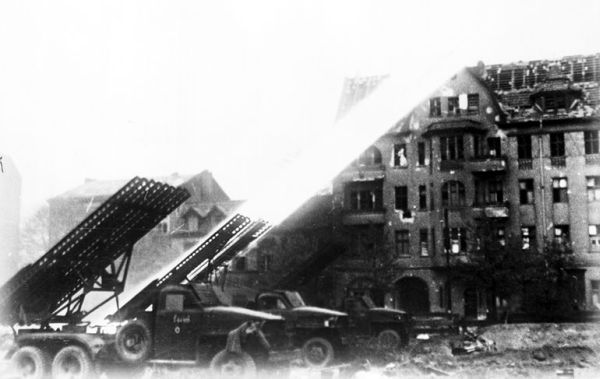
Katusha rockets being fired by the Red Army during the battle of Berlin. Weidling owed his reputation to this battle.
In the night of April 22 to 23, Weidling shifted his headquarters again — to Rudow in the south of Berlin — and he finally succeeded in contacting the O.K.H. (supreme command of the army) and Theodor Busse who ordered him again to try and join 9. Armee. At the precise moment the O.K.H. was forced however to abandon its own headquarters at Zossen, a rumor popped up to the effect that Weidling had again shifted his headquarters to Döberitz near Potsdam. Hitler became so furious about this that he wanted to have Weidling executed on April 23 for cowardice and treason. As soon as Weidling heard this, he hurried to the Führerbunker where he explained the situation to two of Hitler’s closest military, Chef des Generalstabes des Heeres (chief of the general staff of the army), Hans Krebs and Chefadjudant des Oberkommando der Wehrmacht (chief adjutant of the supreme command of the Wehrmacht), Wilhelm Burgdorff. While these two reported to Hitler, Weidling learned from his chief of staff Theodor van Dufving he would have been replaced in the meantime as commander of LVI Panzerkorps. Weidling flew into a rage and also clearly told Krebs and Burgdorff who promised him to revoke the order. But first, Weidling had to come along to see Hitler.
Weidling encountered a fragile Führer, who was visibly impressed though with Weidling’s achievements and ordered him to stay in Berlin with his troops and take up the defense of the eastern and southern sectors. During the night, Weidling succeeded in turning his troops around and returning to Berlin. A day later, on the 24th, the story took an even more bizarre turn when Hitler summoned Weidling back to the bunker and even appointed him on the spot Kampfcommandant (military commander) of the defense of Berlin (except the area around the Reichstag and the Führerbunker where SS-Brigadeführer Wilhelm Mohnke was in charge), all that when a day before he had wanted to have him executed. Weidling is said to have remarked: ‘By the same token, you would have me executed’. As the new commander of Berlin, Weidling had just one demand: only he would be in command of his troops and he would not have to put up with interference by the Minister of Propaganda, Joseph Goebbels and other high ranking Nazis.

German soldiers in Berlin handing over their weapons after their surrender in May 1945. Source: Bundesarchiv Bild 183-WO422-004
Being commander of Berlin, Weidling had only a meager number of men at his disposal. His own LVI Panzerkorps had been weakened considerably and consisted of some 15,000 men in 5 divisions. Little was left of 9. Fallschirmjäger-Division and Panzer-Division Müncheberg had also been severely mauled in battle. Only 20. Panzergrenadier-Division had fared a little better but its commander, General Major Georg Scholze had committed suicide. The only divisions still fit enough for battle were 11. SS-Freiwilligen-Panzergrenadier-Division Nordland and 18. Panzergrenadier-Division. Weidling decided to keep 18. Panzergrenadier-Division in reserve for an eventual counter-attack. The other units were divided over the various defense sectors.
Weidling was to defend Berlin with a total of 45,000 men of the Wehrmacht and the SS and a little over 4,000 men of the Volkssturm. Equipment was scarce as well: for example, only 60 tanks were still available for battle. With this minimal number of equipment and men, Weidling had to counter a Soviet force numbering some 1.5 million men. Consequently, it was no wonder that Berlin was totally surrounded as early as April 25, meaning that resupplying the troops became very difficult indeed. Weidling and his troops were resupplied for the last time by air on April 26, although most of the goods fell into Soviet hands. Meanwhile Weidling had recognized for a long time that Hitler had lost touch with reality and was incapable of making rational decisions but he considered it his duty as loyal officer to continue obeying the Führer.
A day later, April 26, Weidling and his troops had to shift their headquarters again. The building on Hohenzollerndamm was being heavily shelled and therefore they moved to the buildings of the O.K.H. on Bendlerstraße, where the headquarters of the Wehrmacht had been located since 1938. But very soon the section where they had established their headquarters became untenable due to the impact of a bomb and so they moved to a bunker beneath the former Abwehr headquarters on Tirpitzufer, just a few yards from their previous headquarters on Bendlerstraße. The hopeless situation Weidling and his men found themselves in became visible also when Weidling on April 28, in his own words, was left with only 30,000 men, a handful of tanks and diminishing supplies of ammunition and food. After Weidling had learned that units of 12. Armee, commanded by General der Panzertruppe Walther Wenck, had made contact with Generalleutnant Hellmuth Reymann and his Armeegruppe in Potsdam, increasing the possibility of a break out from the center of Berlin, he made a suggestion to Hitler of a massive break out in order to prevent further suffering. He also wanted Hitler to come with him. Hitler found Weidling’s plan excellent on paper but wanted to die at the head of his troops instead of roaming through the forests like a partisan.
On April 29, Weidling reported he was out of ammunition and unable to have his last tanks repaired. On April 30 he received a letter from Hitler containing his last and final order: he was permitted to make a break out, as long as he would join other units and continue the fighting. In case other troops could not be found, the battle was to be continued in small groups in the forests. Capitulation of Berlin was strictly forbidden however. Weidling immediately started planning a break out. However, these plans were postponed when Weidling was summoned to the Reichskanzlei a little after 18:00 hours where he was informed about Hitler’s suicide, earlier that day around 15:15. Weidling now thought things would change and that he and his troops would be free to surrender to the Soviets. Party secretary Martin Bormann and Joseph Goebbels however vehemently opposed unconditional surrender.
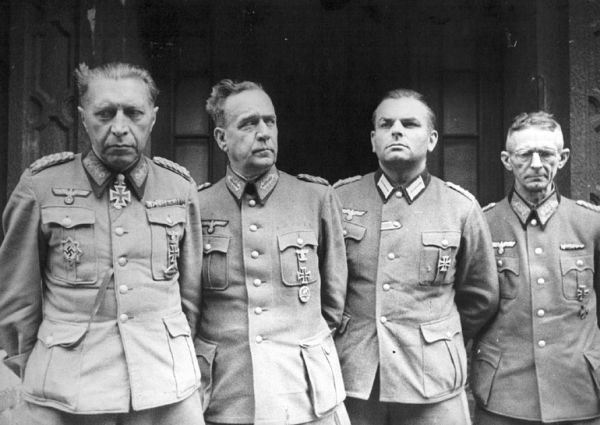
Weidling and other German generals after their surrender to the Red Army, May 2, 1945. Source: World War II Database
Late in the evening of April 30, Weidling assembled his commanders to discuss whether they should try and make a break for it or surrender. It was decided to ask the Soviets for a cease fire and negotiations. On May 1, Oberst Theodor von Dufving, Weidling’s chief of staff went to see Vasily I. Chuikov to offer capitulation. The Soviet general accepted the unconditional surrender. On behalf of Minister of Propaganda Hans Fritzsche. who had been appointed by Hitler shortly before his suicide to succeed Goebbels as the latter was earmarked to succeed Hitler as Reichskanzler, the Germans in Berlin surrendered. On May 2, at 06:00 hours, Weidling and his staff surrendered and he was taken to Chuikov’s headquarters by car. On radio, Weidling ordered the cessation of hostilities in Berlin.
Definitielijst
- Abwehr
- Term used for the German military intelligence unit during the WW1 and WW2. From 1935 onwards under command of Admiral Wilhelm Canaris. The organisation often came into conflict with other secret services such as the SD and the Gestapo. During World War 2 under Canaris frequently a source for conspiracies against the Nazi regime until in 1943 a major conspiracy by a number of prominent members of the Abwehr was discovered and the Abwehr was placed under command of Himmler. After the assassination attempt on Hitler in 1944, Canaris was discharged and the Abwehr was dissolved. The conspirators and Canaris were prosecuted and in 1945 they were executed atc oncentration camp Flossenburg.
- Armeegruppe
- Usually consisted of two or three neighbouring Armees, sometimes German and Axis-allied Armees. One Armee HQ, usually the German, temporarily became the commanding HQ of the other Armees. An Armeegruppe would always be subject to a Heeresgruppe. Later in the war the size of an Armeegruppe or Panzergruppe varied significantly. From 1943 onwards an Armeegruppe could be the size of an Armee or just the size of a corps.
- Capitulation
- Agreement between fighting parties concerning the surrender of a country or an army.
- Fallschirmjäger
- German paratroopers. Part of the Luftwaffe.
- Führer
- German word for leader. During his reign of power Adolf Hitler was Führer of Nazi Germany.
- Heeresgruppe
- The largest German ground formation and was directly subordinate to the OKH. Mainly consisting of a number of “Armeen” with few directly subordinate other units. A Heeresgruppe operated in a large area and could number several 100,000 men.
- Propaganda
- Often misleading information used to gain support among supporters or to gain support. Often used to accomplish ideas and political goals.
- Wehrmacht
- German armed military forces, divided in ground forces, air force and navy.
Epilogue
Weidling himself was taken prisoner and flown to the Soviet Union where he was sentenced, as late as 1952, to 25 years imprisonment for not having ended the battles in Berlin ahead of time. He passed away in Vladimir prison, east of Moscow, on November 17, 1955, at the age of 64. Following a visit by Western Germany’s federal chancellor Konrad Adenauer in September 1955, the last German prisoners of war would return to Germany in January 1956, a few months after Weidling’s death,. Little is known about what happened to Weidling’s remains but it is very likely they have been buried in an unknown location somewhere in Russia.
Looking back on Weidling’s (military) life, his role during the battle of Berlin comes to mind first. Initially, this can be considered remarkable as he had previously fought in the First World War and served as a commander of various Wehrmacht units during the Second World War in Poland, France, and on the Eastern front. In addition, he was only named military commander of Berlin on April 24, the successor of Generalleutnant Hellmuth Reymann when the street fighting was already raging. Consequently, Weidling has never been able to exert any influence worth speaking of on the way Berlin was to be defended. Yet, he was the one who read the capitulation order and called for the cessation of hostilities, actually handing over the city to the Soviets which made him one of the key figures in the battle of Berlin. Regarding his prison sentence, he paid a high price as commander of Berlin during these last days although he seemed to have accepted his fate when he accepted his appointment as commander. It is therefore hard to judge this man, moreover because little is known about his personal thoughts. So, the question remains whether he was an ardent Nazi or a soldier loyal to his profession and his country for which he wanted to keep on fighting until the end.

Memorial stone on the wall of the house where Weidling signed the surrender of his troops on May 2, 1945. Source: Wikimedia Commons / OTFW
Definitielijst
- capitulation
- Agreement between fighting parties concerning the surrender of a country or an army.
- First World War
- Took place from 1914 till 1918 and is also named The Great War. The conflict started because of increased nationalism, militarism and neo-colonialism in Europe. Two alliances battled one another during the 4-year war, which after a dynamic start, resulted into static trench warfare. The belligerents were the Triple Alliance (consisting of Great-Britain, France, and Russia; later enlarged by Italy and the USA, amongst others) on the one hand and the Central Powers (consisting of Germany, Austria-Hungary, Bulgaria and the Ottoman empire) on the other hand. The war was characterized by the huge number of casualties and the use of many new weapons (flamethrowers, aircraft, poison gas, tanks). The war ended in 1918 when Germany and its allies surrendered unconditionally.
- Nazi
- Abbreviation of a national socialist.
- Soviet Union
- Soviet Russia, alternative name for the USSR.
- Wehrmacht
- German armed military forces, divided in ground forces, air force and navy.
Information
- Translated by:
- Arnold Palthe
- Published on:
- 19-01-2025
- Feedback?
- Send it!
